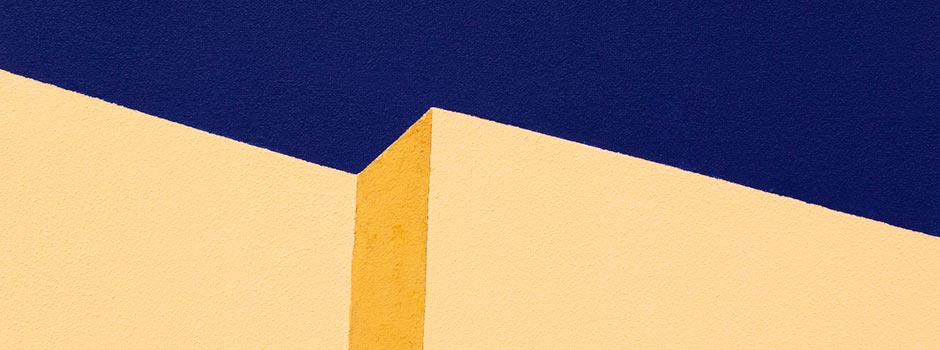
Solo show at Gallery Isabelle van den Eynde (Sep 17 – Nov 1, 2018) Mohammed Kazem: A Prime Activity
Aug 17, 2018 Exhibition

Kazem has been painting since his late teens and early 20s, went on to win the first prize in painting at Muscat Youth Biennial in 1990 and loved the surface so much that he remained consciously aware to the inspiration coming from the medium itself. However, he did not allow himself to be enslaved by a particular medium or a specific pigment, which is visible in his earlier series of intimate watercolours largely inspired by the atelier of his fellow artist Hassan Sharif, in which Kazem would change the predominant colours on each work and create visible differences merely based on pigment experimentation.
In his essay Why are conceptual artists painting again? Because they think it’s a good idea, (Charles Esche and Mark Lewis, A Ferall: A Journal of Art, Context and Enquiry, Issue 12 (Autumn/Winter 2005), pp. 7-16) art critic Jan Verwoert’s discusses the idea of conceptuality versus medium specificity and asks whether painting should be considered in isolation with other media. The exhibition takes this idea forward and discusses this in relation to the conceptual practice of Kazem, which has seen the artist return to painting in recent months. Kazem concurs and adds that the only thing that matters in his artistic practice is the conceptual statement and if it can be adequately communicated through painting, then he paints.
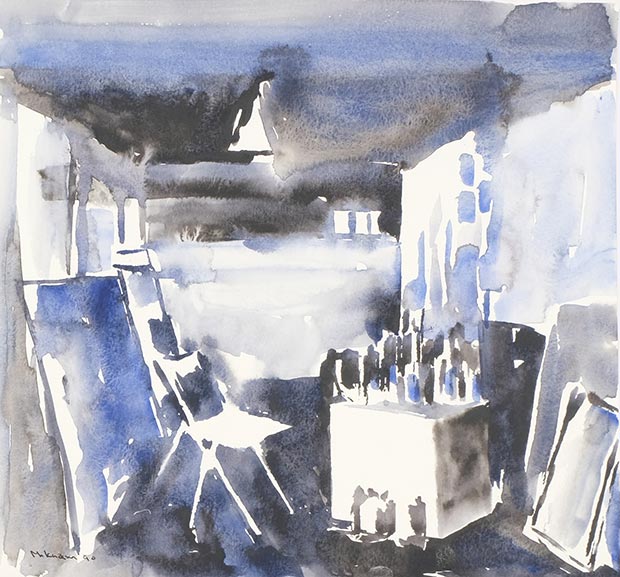 Mohammed Kazem, Studio, 1990, Acrylic on paper, 30 x 33 cm / Courtesy the artist and Gallery Isabelle van den Eynde
Mohammed Kazem, Studio, 1990, Acrylic on paper, 30 x 33 cm / Courtesy the artist and Gallery Isabelle van den Eynde
Kazem acquired the knowledge of art history at a young age and began to paint in an impressionist style, moving on to post-impressionism and finally adapting abstraction. He jokes about the traditional practice of painting outdoors in the harsh UAE climate, where most of his work is taken indoors – back to his air conditioned studio. “I quickly photograph the kitschy aesthetics of the walls connecting each house in my neighbourhood and bring it back to the studio to work on it,†he adds. By removing or disrupting perspectives, Kazem renders flat paintings – something that is more explicitly evident in his recent body of works, entitled Neighbours (2018). He observed that for most traditional neighbourhoods in the UAE, refurbishing meant painting over an existing wall in vibrant colours. This led him to experiment with decorative painting techniques predominant in the region. “The process demands me to learn how to paint like a painter, not an artist.†A wood relief imitating an exterior wall or a painting of a meticulously detailed air conditioner trace the ephemeral human connection and bring this narrative into the ever-changing urban landscape. The textures in Neighbours (2018) mirror the thick impasto from Kazem’s early abstract paintings, and the protruding details reference his more commonly known scratches on paper that first appeared in 1990 and continue to inform a major aspect of his practice today.
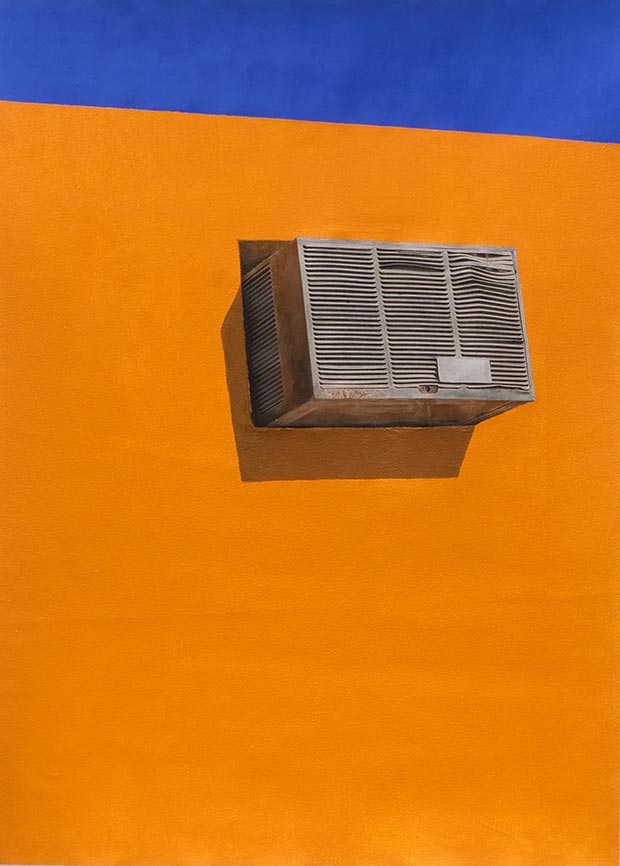 Mohammed Kazem, Neighbours, 2018, Acrylic on canvas, 140 x 105 cm / Courtesy the artist and Gallery Isabelle van den Eynde
Mohammed Kazem, Neighbours, 2018, Acrylic on canvas, 140 x 105 cm / Courtesy the artist and Gallery Isabelle van den Eynde
 Mohammed Kazem, Neighbours, 2018, Oil primer and exterior wall paint on MDF panel, 75 x 120 x 8 cm / Courtesy the artist and Gallery Isabelle van den Eynde
Mohammed Kazem, Neighbours, 2018, Oil primer and exterior wall paint on MDF panel, 75 x 120 x 8 cm / Courtesy the artist and Gallery Isabelle van den Eynde
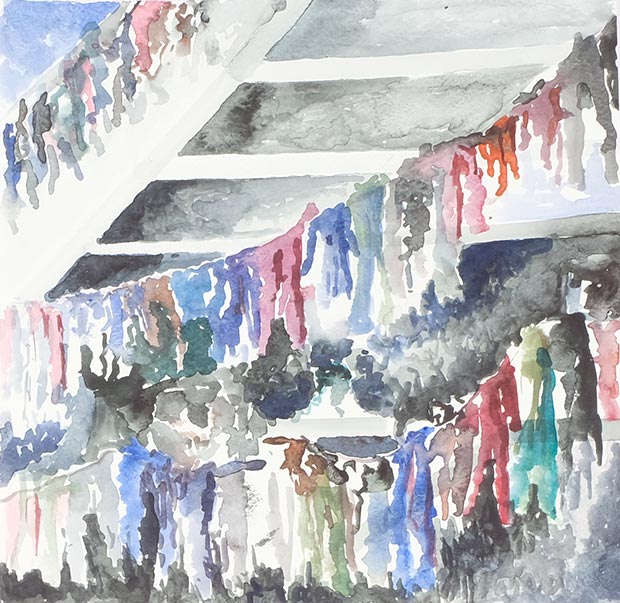 Mohammed Kazem, Neighbours, 2018, Watercolour on paper, 25 x 25 cm / Courtesy the artist and Gallery Isabelle van den Eynde
Mohammed Kazem, Neighbours, 2018, Watercolour on paper, 25 x 25 cm / Courtesy the artist and Gallery Isabelle van den Eynde
Very early on, scratches had confirmed Kazem’s stylistic redirection from painterly figuration towards abstractions. This is evident in Horizon (2015), a series of 25 by 70 cm works that draw inspiration from much of the artist’s time spent in sea. In Horizon, contrary to his other scratched works, the artist first paints the surface of the paper and then punctuates it to reveal the texture in an organic pattern.
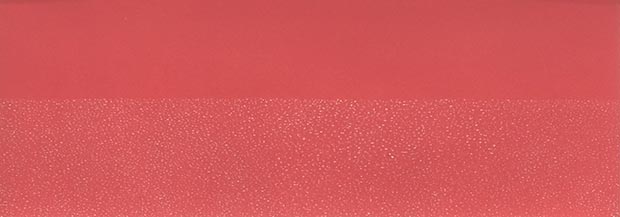 Mohammed Kazem, Horizon, 2015, Acrylic on scratched paper, 25 x 70 cm / Courtesy the artist and Gallery Isabelle van den Eynde
Mohammed Kazem, Horizon, 2015, Acrylic on scratched paper, 25 x 70 cm / Courtesy the artist and Gallery Isabelle van den Eynde
Continuously revisiting his practice and using the antithesis of his own ideas, Kazem uses varying intensity of pigment saturation to illustrate human connection in his immediately sharp and contrasting new photographs from Kisses (2017). He imagines the myriad possible links between the chewed gum that dots the sidewalks of Seoul, drawing lines between them in brightly coloured powdered pastel and humorously titling them ‘Kisses’. Following the same idea is another series of large-scale flattened paintings that are in seemingly direct opposition to the whitewashed works from late 1980s.
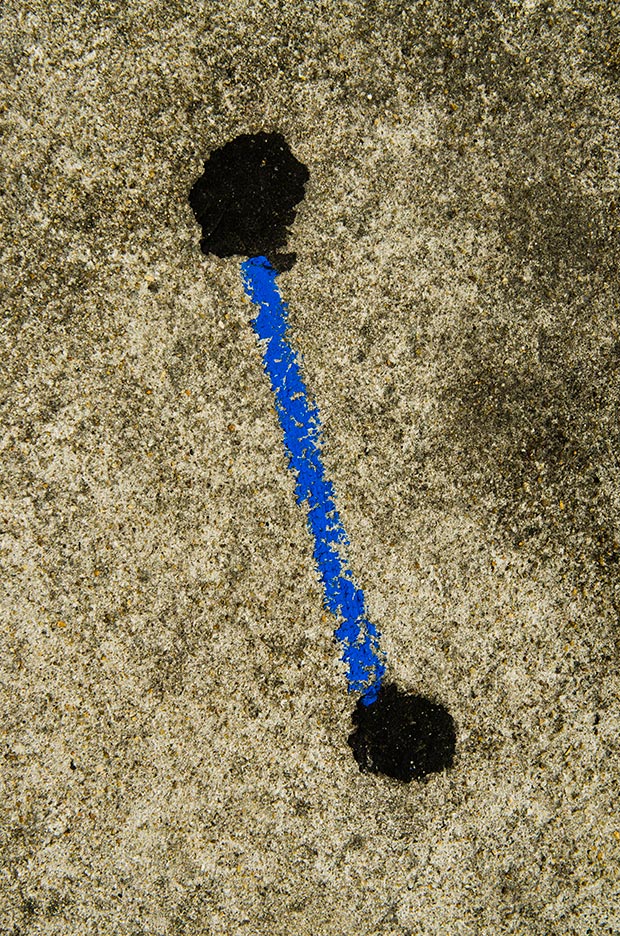 Mohammed Kazem, Kisses, 2017, Inkjet print on Hahnemuhle Fine Art Paper, 120 x 86.6 cm / Courtesy the artist and Gallery Isabelle van den Eynde
Mohammed Kazem, Kisses, 2017, Inkjet print on Hahnemuhle Fine Art Paper, 120 x 86.6 cm / Courtesy the artist and Gallery Isabelle van den Eynde
Also entitled Neighbours (2018), layers of dark coloured acrylic and ink wash over the canvas in multiple layers allowing Kazem to conceal the scene from the viewer to reveal only part of the composition through a thick veil of smoke. Kazem presents paintings in which elements of figurative art are abstracted and incorporated in his generally flat colour surfaces. They become quiet and contemplative, blurring the perception if we are looking at the work in terms of its materials and formal elements and not in subjective content.
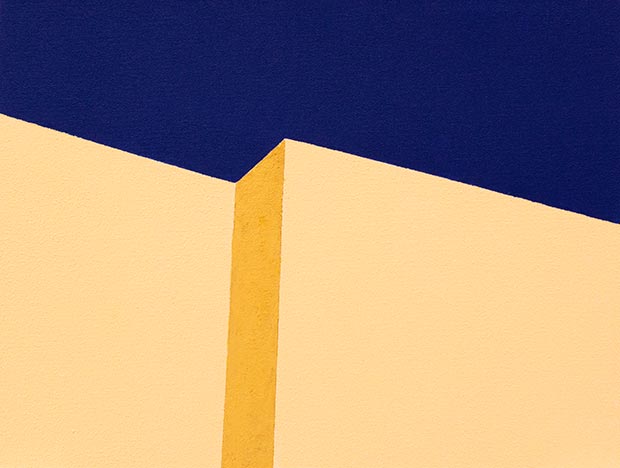 Mohammed Kazem, Neighbour No. A8, 2018, Acrylic on canvas board, 30.5 x 40.5 cm / Courtesy the artist and Gallery Isabelle van den Eynde
Mohammed Kazem, Neighbour No. A8, 2018, Acrylic on canvas board, 30.5 x 40.5 cm / Courtesy the artist and Gallery Isabelle van den Eynde
While painting remained a major aspect of Kazem’s early practice, now more than 30 years later, he is still fascinated by collecting and documenting information about unimportant objects and traces of our present within a particular environment. In his monograph published in 2013, Hassan Sharif wrote, “The meaning or purpose of his [Kazem’s] paintings lies in the life of the colours and the ways they can be put to use, not in the painted objects themselves.â€
Born 1969 in Dubai, he lives and works in Dubai. He has developed an artistic practice that encompasses video, photography and performance to find new ways of apprehending his environment and experiences. Throughout his practice, Kazem has tried to capture the un-capturable. From his own body and the objects of his quotidian to nature itself, Kazem senses what is immeasurable, sometimes even un-seeable, and transfigures it into a visual work. Since the mid 1990s, he began scratching paper with the edge of a pair of scissors, where he lifts the surface of the paper creating monochrome Braille-like networks of bumps, depressions and relief works on paper that represent sound and which he titles Scratches on Paper, Sound of Angles, Sound of Light, and Sound of Objects.
Kazem was a member of the Emirates Fine Arts Society early in his career and is acknowledged as one of the 'Five', an informal group of Emirati artists – including Hassan Sharif and Abdullah Al Saadi – at the vanguard of conceptual and interdisciplinary art practice. In 2012, he completed his Masters in Fine Art at the University of the Arts, Philadelphia. In recent years, he has participated in several group shows at the Guggenheim Abu Dhabi (2017), Guggenheim New York (2016), the Yinchuan Biennale (2016), Sharjah Biennial (2015), Gwangju Museum of Art (2014), Fotofest Biennial in Houston (2014), Boghossian Foundation (2013), and Mori Art Museum (2012), amongst others. In 2013 he represented the UAE’s National Pavilion at the Venice Biennale with an immersive video installation entitled Walking on Water, curated by Reem Fadda, and in 2015 he showcased works from the Tongue series at 1980 – Today: Exhibitions in the UAE, curated by Hoor Al Qasimi. His works are held in the collections of the British Museum, London; Guggenheim Abu Dhabi and New York; Mathaf, Arab Museum of Modern Art, Doha; Ullens Centre for Contemporary Art, Beijing; Sharjah Art Foundation, Shrajah; Barjeel Art Foundation, Sharjah and Vehbi Koç Foundation, Istanbul; among others.
Comments
Add a comment